Votes for Women Reading Answers
7 min read
Updated On
-
Copy link
Table of Contents

Limited-Time Offer : Access a FREE 10-Day IELTS Study Plan!
The Reading Module of the IELTS can be the top-scoring category, with diligent practice. To achieve the best results in this section, you must understand how to approach and answer the different Question types in the Reading Module. By solving and reviewing Sample Reading Questions from past IELTS papers, you can ensure that your Reading skills are up to the mark.
The Academic passage ‘Votes for Women‘ is a reading passage that appeared in an IELTS Test. Try to find the answers to get an idea of the difficulty level of the passages in the actual reading test. If you want more passages to solve, try taking one of our IELTS reading practice tests.
The question types found in this passage are:
Multiple Choice Questions
IELTS reading multiple choice questions have about 3-4 options from which we have to choose our answer. This might be in the form of a question & answer type or a choose a correct ending to a sentence type. These answers appear in chronological order according to the passage.
Note Completion
In the Note Completion Question, you will be asked to complete a set of notes based on the information given in the text. Sometimes the question will be to write a short answer and sometimes you’ll have to choose from the list of answers given. Usually, these kinds of questions will only be based on one part of the passage, so you won’t have to read the whole passage to fill in the important information.
Yes/No/Not Given Questions
Similar to the True/False/Not given questions, Yes/No/Not given questions also have various statements. But here you are asked to agree or disagree with the statement based on the opinion of the author.
You should spend 20 minutes on answering questions 1-14 based on the reading passage given below.
Votes For Women
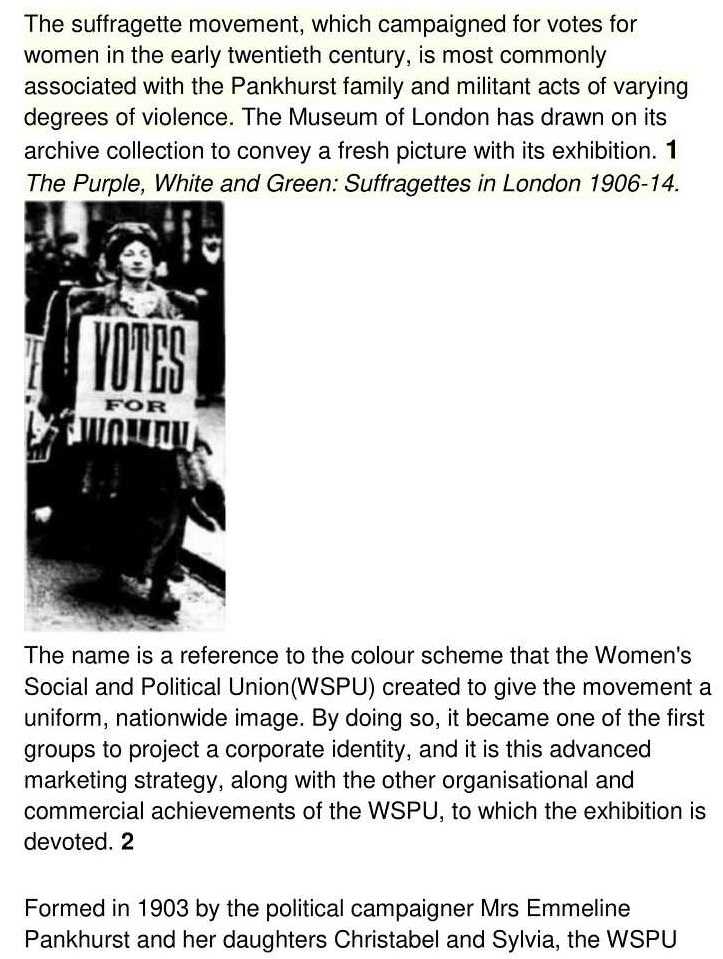
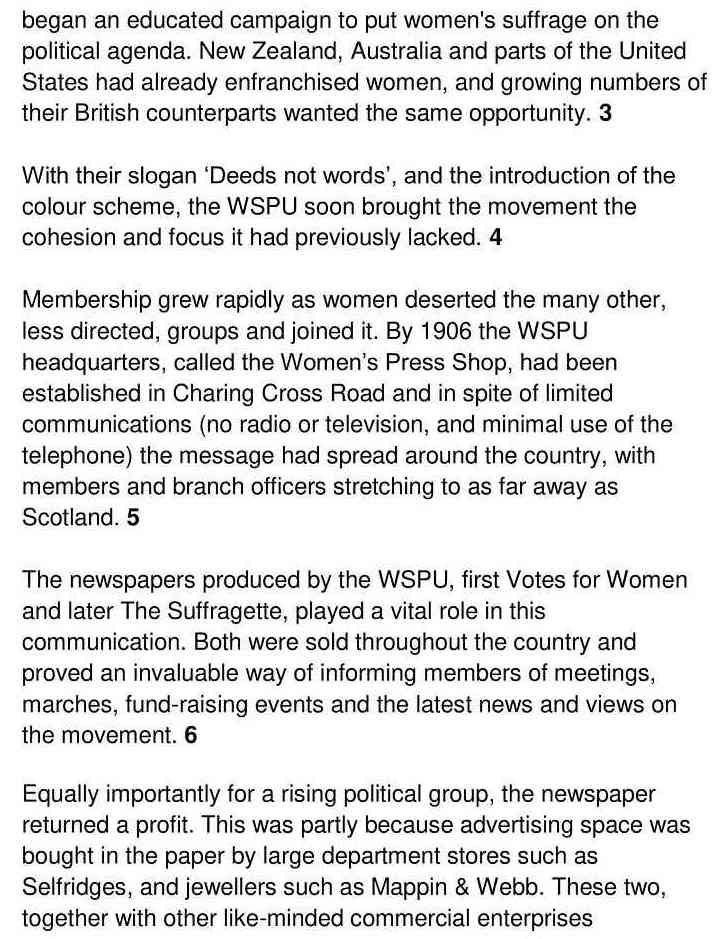


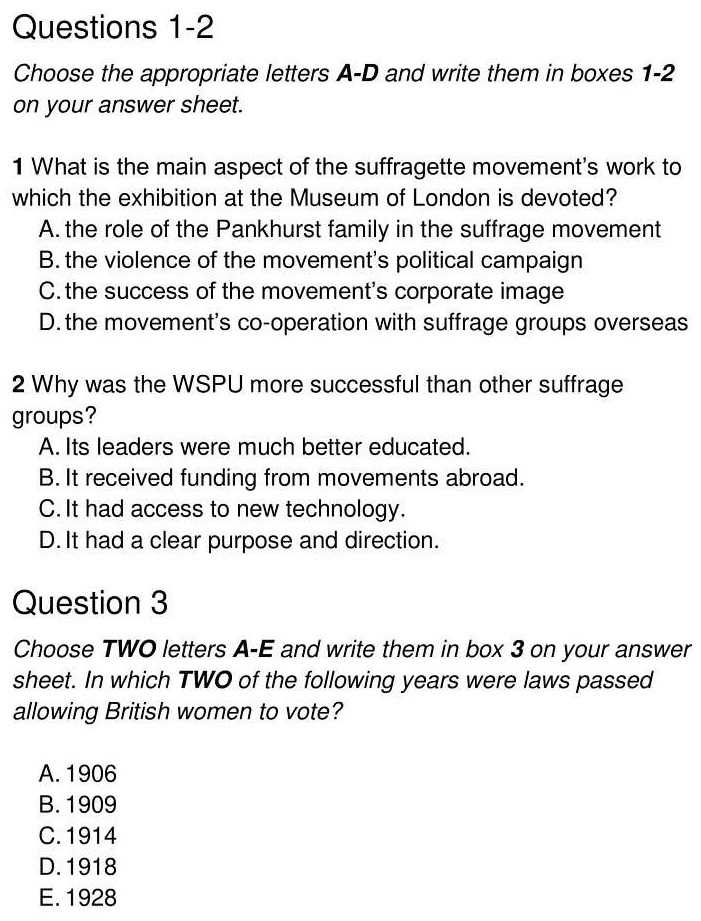

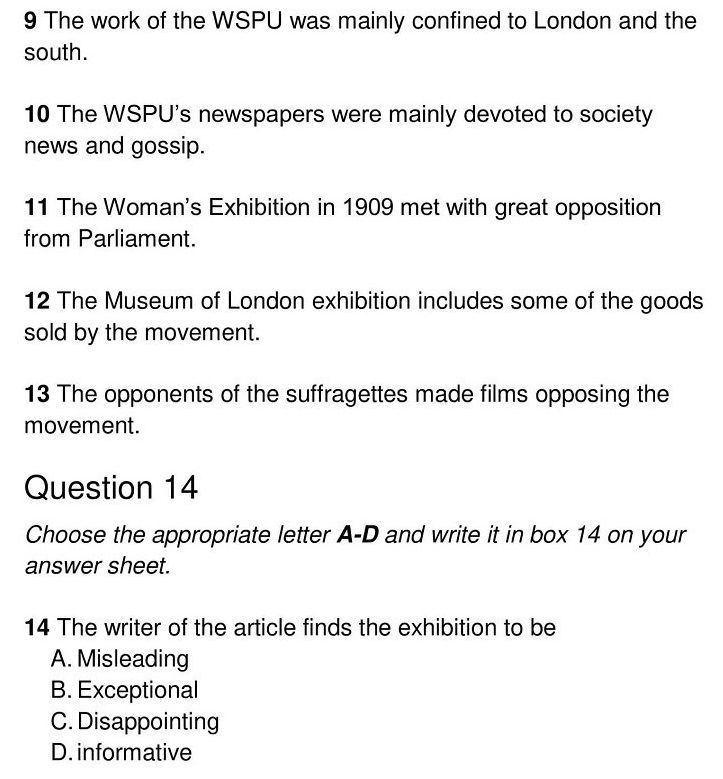
Answers
Unlock Answers
The answers to questions 1-14 are given below with their explanations.
1 Answer: C
Question Type: Multiple Choice Questions
Answer location: Paragraph 1, last line; Paragraph 2, line 2
Answer explanation: In paragraph 1, the author states that the ‘suffragette movement’ campaigned for votes for women in the early twentieth century. The ‘Museum of London’ has drawn on its archive collection to ‘convey a fresh picture with its exhibition’, The Purple, White and Green: Suffragettes in London 1906-14. Paragraph 2 further adds that the name is a reference to the colour scheme that the Women’s Social and Political Union (WSPU) created to ‘give the movement a uniform, nationwide image’. By doing so, it became ‘one of the first groups to project’ (success) ‘a corporate identity’ (main aspect).
2 Answer: D
Question Type: Multiple Choice Questions
Answer location: Paragraph 4
Answer explanation: A line in the said paragraph conveys that with their slogan ‘Deeds not words’, and the introduction of the colour scheme, the ‘WSPU soon brought the movement’ the ‘cohesion and focus’ (purpose and direction) ‘it had previously lacked’ (in other suffrage groups before this).
3 Answer: D and E
Question Type: Multiple Choice Questions
Answer location: Paragraph 15, line 1
Answer explanation: If you read thoroughly, there’s a line that claims that although the exhibition officially charts the years 1906 to 1914, graphic display boards outlining the bills of ‘enfranchisement of 1918 and 1928’ (laws passed), which ‘gave the adult female populace of Britain the vote’ (allowing British women to vote), show what was achieved.
4 Answer: Advertising space
Question Type: Note Completion
Answer location: Paragraph 7, line 2
Answer explanation: A line in the said paragraph discusses how the ‘newspaper’ became equally important for a rising political group to ‘return a profit.’ This was partly because ‘advertising space was bought in the paper’(which helped WSPU to raise money) by large department stores such as Selfridges, and jewellers such as Mappin & Webb.
5 Answer: Colour scheme(purple, white, green)
Question Type: Note Completion
Answer location: Paragraph 7, line 2
Answer explanation: If you observe, in the said paragraph Paragraph 8 illustrates the creation of the ‘colour scheme’ ‘provided another money-making opportunity’ (merchandising activities) which the WSPU was quick to exploit. The group began to sell ‘playing cards, board games, Christmas and greeting cards, and countless other goods’ (a large variety of goods), ‘all in the purple, white and green colours’ (colour scheme of WSPU).
6 Answer: The Woman’s Exhibition
Question Type: Note Completion
Answer location: Paragraph 9, line 1
Answer explanation: In the said paragraph, refer that, the ‘paper and merchandising activities alone did not provide sufficient funds’ for the WSPU to meet organisational costs, so ‘numerous other fund-raising activities’ (additional fund-raising activities) combined to fill the coffers of the ‘war chest’. The ‘most notable of these was the Woman’s Exhibition’, which took place in 1909 in a Knightsbridge ice-skating rink, and ‘in 10 days raised the equivalent of £250,000 today’.
7 Answer: NO
Question Type: Yes/No/Not Given Questions
Answer location: Paragraph 3, line 1
Answer explanation: Paragraph 3 mentions that the ‘WSPU, formed in 1903, began an educated campaign to put women’s suffrage on the political agenda’. New Zealand, ‘Australia’ and parts of the United States ‘had already enfranchised women’ (before 1903). Hence, the answer is ‘NO’ as the statement contradicts the writer.
8 Answer: YES
Question Type: Yes/No/Not Given Questions
Answer location: Paragraph 6, line 1
Answer explanation: If you observe clearly, it is mentioned that the ‘newspapers produced by the WSPU’, the ‘Votes for Women’ and ‘The Suffragette’, played a ‘vital role in this communication’ (main organs of communication). Hence, the answer is ‘YES’ as the statement reflects the situation as described by the writer.
9 Answer: NO
Question Type: Yes/No/Not Given Questions
Answer location: Paragraph 5, last line
Answer explanation: In paragraph 5, the writer has written that ‘by 1906 the WSPU headquarters’, called the Women’s Press Shop, had been established in Charing Cross Road and in spite of limited communications (no radio or television, and minimal use of the telephone) the ‘message had spread around the country’, with ‘members and branch officers stretching to as far away as Scotland’. This means it was not confined mainly to London and the south.
10 Answer: NO
Question Type: Yes/No/Not Given Questions
Answer location: Paragraph 6, last line
Answer explanation: The answer is clearly mentioned in the said paragraph and line. In the passage, it is said that the ‘newspapers produced by the WSPU’, first Votes for Women and later The Suffragette, played a vital role in this communication. Both were sold throughout the country and ‘proved an invaluable way of informing members of meetings, marches, fund-raising events and the latest news and views on the movement’. It means that neither of the newspapers provided any society news or gossip.
11 Answer: NOT GIVEN
Question Type: Yes/No/Not Given Questions
Answer location: Paragraph 9
Answer explanation: The only information about the Woman’s Exhibition is given in paragraph 9 that points out that it was the most notable of these was the Woman’s Exhibition, which took place in 1909 in a Knightsbridge ice-skating rink, and in 10 days raised the equivalent of £250,000 today. As there is no mention of any opposition from Parliament, the answer is ‘NOT GIVEN’.
12 Answer: YES
Question Type: Yes/No/Not Given Questions
Answer location: Paragraph 10, line 2
Answer explanation: Paragraph 10 brings out the fact that the ‘Museum of London’s exhibition’ is largely visual, with a huge number of items on show like ‘copies of The Suffragette, campaign banners and photographs are all on display, together with one of Mrs Pankhurst’s shoes and a number of purple, white and green trinkets’ (some of the goods that belonged to the movement). Hence, the answer is ‘YES’ as the statement reflects the situation as described by the writer.
13 Answer: YES
Question Type: Yes/No/Not Given Questions
Answer location: Paragraph 13, last line
Answer explanation: If you read thoroughly, there’s a line that informs, visitors can watch a short film made up of old newsreels and cinema material which clearly reveals the political mood of the day towards the suffragettes. The programme begins with a ‘short film’ ‘devised’ (made) by ‘the ‘antis’- those opposed to women having the vote’ (opponents of the movement) – depicting a suffragette as a fierce harridan bullying her poor, abused husband.
14 Answer: D
Question Type: Multiple Choice Questions
Answer location: Paragraph 15, 2nd last line
Answer explanation: Few lines in the passage refers to the fact that the exhibition demonstrates how advanced the suffragettes were in their thinking, in the marketing of their campaign, and in their work as ‘shrewd and skilful image-builders’. It also ‘conveys a sense of the energy and ability the suffragettes’ brought to their fight for freedom and equality. And it illustrates the ‘intelligence employed by women’ (informative women) who were at that time deemed by several politicians to have ‘brains too small to know how to vote’.
Check More IELTS Reading Answers
Also check :
Practice IELTS Reading based on question types

Start Preparing for IELTS: Get Your 10-Day Study Plan Today!
Recent Articles

Nehasri Ravishenbagam

Haniya Yashfeen

Haniya Yashfeen

Haniya Yashfeen
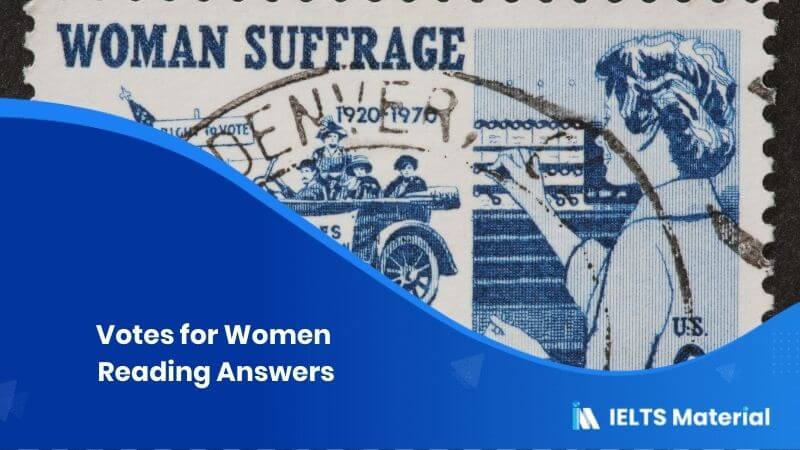



Post your Comments